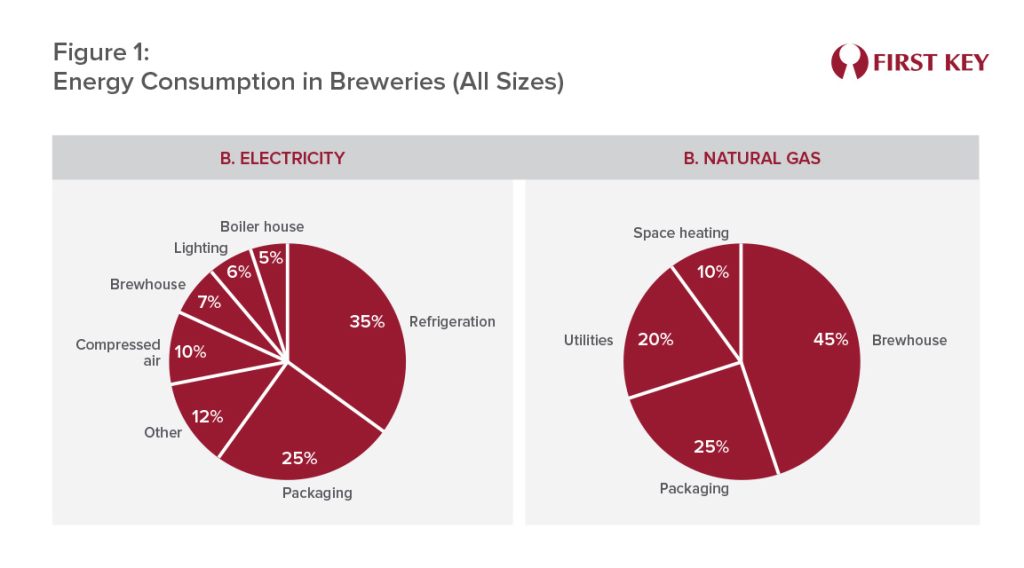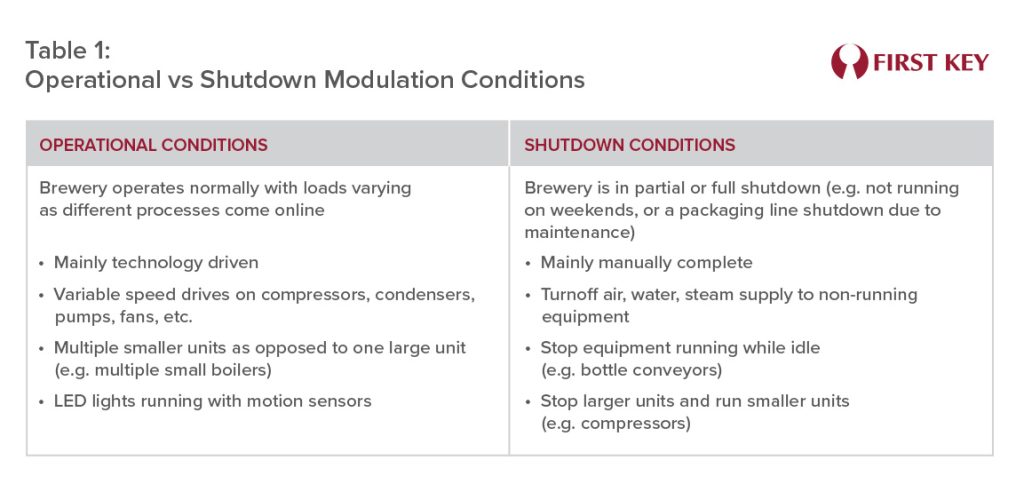A proven strategy to improve equipment reliability, operational efficiency, and product quality.
In the competitive landscape of the brewing industry, operational efficiency isn’t just about producing the best beer; it’s also about sustainability and managing costs effectively. A critical aspect of this efficiency is energy management. This article explores a proven strategy for improving equipment reliability, operational efficiency, and product quality through modulation and equipment shutdown. Drawing inspiration from Simon Sinek’s “Start with Why” framework, it’s essential to understand the rationale behind energy efficiency measures to implement them successfully.
Modulation, in the context of brewery operations, refers to adjusting the power output of equipment to match the actual demand. This strategy prevents the unnecessary running of machinery at full capacity, optimizes energy usage, enhances equipment reliability, and improves product quality. By implementing modulation, breweries can mitigate the wear and tear on their equipment, leading to longer lifespans and fewer operational disruptions.
The significance of modulation lies in its ability to align energy consumption with production needs precisely. Energy can account for 3-8% of beer production costs and may experience price volatility [1] [7]. Figure 1 below shows data from the US Environmental Protection Agency (EPA) showing that refrigeration, packaging, and compressed air consume 70% of US Breweries’ electrical use (A), whereas the brewhouse dominates natural gas and coal use at 45% (B) [3]. This targeted approach to energy use prevents the wasteful running of equipment, thereby conserving energy, reducing operational costs, and minimizing environmental impact. The ripple effects of modulation extend beyond energy savings, contributing to enhanced equipment reliability and improved product consistency, which are crucial for maintaining and elevating brand reputation.

Empowering Brewery Teams for Effective Modulation and Shutdown
To be effective, brewery employees must be well-versed in modulation and equipment shutdown strategies. Training programs aimed at educating employees about the principles of modulation, the importance of energy conservation, and the procedures for equipment management are crucial. By empowering the staff, breweries can foster a workforce capable of making informed decisions that align with energy efficiency goals.
Assigning clear roles and responsibilities ensures the smooth execution of these strategies. This may involve designating teams to monitor energy usage and manage equipment maintenance, promoting accountability and efficiency. Furthermore, recognizing and rewarding employees who contribute to energy-saving initiatives can cultivate a culture of sustainability within the organization.
Creating a Modulation Plan
Developing an effective modulation strategy begins with identifying or calculating the brewery baseload—the minimum level of energy consumption necessary for maintaining essential operations. This calculation helps identify potential energy-saving opportunities during periods of low production. A comprehensive communication plan is vital to articulate the reasoning behind energy efficiency measures and ensure all stakeholders are working towards a common goal.
There are two modulation conditions to consider when developing, managing, and executing a brewery modulation strategy – operational modulation conditions and shutdown modulation conditions. Table 1 below highlights the key differences between these two types of modulation conditions and provides examples for each. Developing modulation plans tailored to both operational and shutdown conditions is critical for optimizing efficiency and seizing opportunities.

Creating detailed timelines for modulation events, such as maintenance periods or holidays, helps align energy-saving measures with production schedules, minimizing the impact on beer availability. Regular cross departmental planning meetings leading up to the modulation event facilitate ongoing discussion, allowing for adjusting strategies as needed. Additionally, leveraging visual tools can aid in tracking and communicating efforts while developing standard operating procedures (SOPs) for equipment startup and shutdown processes, including modulation items and streamlining operations.
A modulation plan may be formatted in a Gantt chart highlighting key events and times. Examples of critical events may include when the last brew clears the brewhouse, the last case packaged, final CIP completion, powerhouse milestones (e.g., boiler or air compressor shutdown), and t-minus start-up milestones (e.g., start-up boiler, start CIP plan). Clear and consistent communication before and after modulation events is the backbone of a successful modulation plan. It ensures that every team member is aligned, potential risks are mitigated, and any issues that arise during the transition periods are quickly documented and addressed, enabling the brewery to maintain efficiency and avoid costly downtime.
Modulation Plan Execution
Executing a brewery modulation plan requires careful coordination and attention to detail to ensure smooth transitions in production output and operational efficiency. One critical element of this process is having a dedicated person physically walk through the brewery to verify that all modulation efforts are being executed as intended. This individual plays a vital role in identifying inconsistencies, such as air leaks or equipment malfunctions, which can compromise product quality or energy efficiency. Staffing maintenance teams during modulation is equally essential, as they must be readily available to fix issues like air leaks or recalibrate equipment in real-time. Identifying and fixing air leaks when production equipment is shut down can lead to significant energy savings and keep the modulation goals on track. These actions help to minimize downtime and prevent costly delays, ensuring the brewery continues to operate efficiently during the modulation phase.
When demand allows, shutting down redundant utility equipment, such as air and ammonia compressors, can lead to substantial energy savings. This practice ensures that only necessary equipment is operational, reducing overall energy consumption [3][4].
Post Modulation – Review of Results
After the modulation period, reviewing the results with the brewery teams is crucial. Real-time energy usage data is generally available online on utility provider accounts. Analyze the energy data to identify missed opportunities and determine if any SOPs need updating or visual labels within the brewery need to be created. This review process helps refine the modulation plan and improve future energy-saving efforts [2].
Best Practices for Effective Brewery Modulation
Participating in demand response programs offered by utility companies can provide financial incentives, reduce utility bills, and improve regional energy reliability. These programs encourage breweries to reduce energy usage during peak demand periods, contributing to grid stability [6][7].
Integrating lights with sensors can significantly enhance energy efficiency by automatically adjusting lighting levels based on occupancy and natural light availability. These sensor-driven lights ensure that areas like brewing floors, storage rooms, and walkways are only illuminated when necessary, preventing energy waste in unoccupied or well-lit spaces. By dynamically controlling lighting, breweries can reduce overall energy consumption, particularly during off-peak hours or in low-traffic zones. Additionally, sensor-based lighting helps streamline brewery operations by allowing staff to focus on production without worrying about manual adjustments, contributing to a more sustainable and cost-effective energy management strategy [1].
An adequate system to report and promptly fix leaks is essential for maintaining operational efficiency and controlling energy costs. Leaks, particularly air and steam leaks, can lead to significant energy waste, disrupt production processes, and increase utility expenses. An efficient reporting system ensures that staff can quickly identify and report leaks, enabling maintenance teams to address the issue before it escalates. Real-time communication between employees and maintenance teams is crucial, allowing quick repairs that minimize downtime and prevent further energy loss. This proactive approach supports smooth modulation efforts and helps breweries achieve energy conservation and sustainability goals [1].
Although typically a capital expenditure, investing in Variable Speed Drives (VSDs) and Variable Frequency Drives (VFDs) allows for precise control of equipment power output, matching it to actual demand. These drives bring savings to pumps, fans, compressors, HVAC systems, and packaging line conveyor belts. By adjusting voltage and frequency, these drives help motors operate at the most efficient speed for any given use, and once they are installed, they work automatically. This technology can significantly enhance energy efficiency and reduce operational costs [2][4][5].
Energy modulation can be seamlessly integrated with modern brewing process control systems. By incorporating real-time energy monitoring and adaptive control technologies, breweries can optimize energy use during production, reducing consumption during peak cost periods and improving overall efficiency. This integration lowers operational costs and enhances process automation, allowing brewers to maintain product quality while achieving energy savings. Implementing modulation ensures that energy usage is dynamically adjusted, aligning with production demands and cost-saving goals.
Summary
Modulation and energy efficiency are the cornerstones of sustainable and cost-effective brewery operations. Breweries can significantly improve their operational efficiency, equipment reliability, and product quality through modulation and strategic equipment shutdown. However, the successful implementation of these strategies hinges on a well-informed and empowered workforce, precise planning and communication, and ongoing evaluation and adjustment. By embracing these practices, breweries can navigate the path toward sustainability, ultimately contributing to a healthier planet and a more competitive position in the market. Modulation is a proven strategy to improve equipment reliability, operational efficiency, and product quality.
The future of energy costs is uncertain, with prices expected to fluctuate due to rising demand, regulatory changes, and the shift towards renewable energy sources. These fluctuations can significantly impact the profitability of breweries, which consume substantial energy for heating, cooling, and production. First Key Consulting can assist breweries in developing a comprehensive energy modulation plan.
References
[1] https://www.energystar.gov/sites/default/files/buildings/tools/LBNL-50934.pdf
[2] https://www.precisionfermentation.com/blog/small-changes-big-impact-economizing-energy-expenses/
[3] https://www.brewersassociation.org/attachments/0001/1530/Sustainability_Energy_Manual.pdf
[4]https://www.researchgate.net/publication/237260016_Energy_Efficiency_Improvement_and_Cost_Saving_
Opportunities_for_Breweries_An_ENERGY_STARR_Guide_for_Energy_and_Plant_Managers
[5] https://www.efficiencyvermont.com/blog/how-to/make-the-most-of-variable-frequency-drives
[6] https://www.sciencedirect.com/science/article/abs/pii/S0360544220318892
[7] https://goenergylink.com/blog/how-to-improve-your-brewerys-energy-efficiency/



